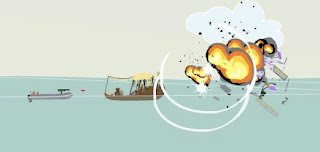A lot of people who try to start their own businesses, especially in game development, talk about the dangers of doing contract work. It can be dangerous because, as a wise man, Adrian Sannier, once told me, "Contract work can become an IV needle stuck in your arm pumping cash right into your veins. Once you get that needle in your arm, it's hard to take it out."
His point was that you can get into a lucrative cycle with contract work, where you try to use it to raise money for your business, but really just end up continuing to do it since it's more secure and cushy than starting your own game company.
However, as Mike and I have experienced in the last couple days, it has some great benefits that can be used for your game company. Besides the obvious extra money, the main one we noticed is inspiration for innovative game ideas.
 Depending on the type of work involved, contract work can be a great means of inspiration. Mike and I have been taking a little time here and there to get going on a logo animation for Nate Beaird's company Tri-Factor. Nate is a friend I met at Immersion here in Des Moines. He wanted an animation that involved some pixie-like particles swirling around to form his logo, which is based on a triquetra, an ancient symbol commonly used in Christianity to represent the Trinity.
Depending on the type of work involved, contract work can be a great means of inspiration. Mike and I have been taking a little time here and there to get going on a logo animation for Nate Beaird's company Tri-Factor. Nate is a friend I met at Immersion here in Des Moines. He wanted an animation that involved some pixie-like particles swirling around to form his logo, which is based on a triquetra, an ancient symbol commonly used in Christianity to represent the Trinity.
I don't really have access to After Effects or Motion, so I figured I could just use Flash to set things up. And of course Mike's programming prowess would ensure the animation behavior was appropriately awesome. So Mike and I teamed up to tackle the project.
We're very satisfied with the result so far (we're not finished), which I've uploaded to our website: Tri-Factor logo animation. Please note that performance is a bit slow at this point, so change the quality to Low if you're running into problems. Shown at left is some frames captured at full-screen.
Once things started to come together yesterday, Mike and I realized how great it would be to use this in a game somehow. I realized that doing small jobs like this could definitely help people come up with ideas that they wouldn't normally come up with.
With this in mind, I've established some guidelines for choosing contract work that can inspire your game ideas:
1. Have enough time to finish the job (and do it well). This is a service for other people, so you should take it very seriously. It can be easy to get wrapped up with lots of other things, so make sure you've set aside time to work on it.
2. Keep the projects small. Yes, you want to set aside time to work on it, but don't go too far. This is stuff you're doing on the side to get inspired. The main goal is to create your art/product, so make sure your time is divided to represent that.
3. Keep the work relevant. If the work is going to inspire you, it should be somewhat relevant to your field, i.e. game development. In our case, the work is an animation, and we made it interactive. The interactive part is what can be the most inspiring.
4. Keep the work creative. A Flash website for an accounting company might be interactive, which is relevant, but it's not the most creative work you can do. By choosing something creative, you are giving yourself the opportunity to solve problems in a more artistic way. This will exercise the right side of your brain, which you do when you're trying to think of unique game ideas. In my experience, creative projects tend to inspire the most.
5. Get paid reasonably. You're devoting time and hard work to this, so make it worth it. Besides, you're likely poor and you need the money anyway.

